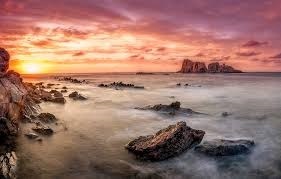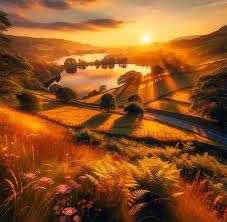The term “Golden Hour” refers to the period shortly after sunrise and just before sunset, when the sunlight is softer and warmer compared to other times of the day.
This unique lighting condition has several beneficial effects, particularly in the fields of photography and videography.
In photography, the golden hour is the period of daytime shortly after sunrise or before sunset, during which daylight is redder and softer than when
the sun is higher in the sky.
The golden hour is also sometimes called the “magic hour,” especially by cinematographers and photographers. During these times, the brightness
of the sky matches the brightness of streetlights, signs, car headlights and lit windows.
The period of time shortly before the magic hour at sunrise, or after it at sunset, is called the “blue hour”. This is when the sun is at a significant
depth below the horizon, when residual, indirect sunlight takes on a predominantly blue shade, and there are no sharp shadows because the sun either
has not risen, or has already set.
Characteristics of the Golden Hour
Soft Light: The light during the Golden Hour is diffused and less harsh, reducing shadows and creating a soft glow on subjects.
Warm Tones: The light has a golden hue, adding warmth and richness to photographs and videos.
Long Shadows: The angle of the sun during this time creates long, interesting shadows that add depth and dimension to images.
Even Exposure: The softer light ensures that highlights and shadows are balanced, making it easier to achieve well-exposed images without harsh contrasts.
Read also: https://www.youtube.com/watch?v=rFKAKBeX6aU
Benefits for Photography and Videography
Portraits: The warm, flattering light is ideal for capturing skin tones and creating a natural look.
Landscapes: The Golden Hour enhances the colors and textures of natural scenes, making landscapes appear more vivid and dynamic.
Architecture: Buildings and structures can benefit from the long shadows and warm tones, highlighting their details and creating dramatic effects.
A Glimpse of the Golden Hour

When the sun is low above the horizon, sunlight rays must penetrate the atmosphere for a greater distance, reducing the intensity of the direct light, so that
more of the illumination comes from indirect light from the sky, reducing the lighting ratio. This is technically a type of lighting diffusion. More blue light
is scattered, so if the sun is present, its light appears more reddish. In addition, the sun’s low angle above the horizon produces longer shadows.
The term hour is used figuratively; the effect has no clearly defined duration and varies according to season and latitude. The sun’s altitude determines the
character of the lighting, and the time for the sun to move from the horizon to a specified altitude depends on a location’s latitude and the time of year. In Los Angeles,
California, at an hour after sunrise or an hour before sunset, the sun has an altitude of about 10–12°. For a location closer to the Equator, the same altitude is reached
in less than an hour, and for a location farther from the equator, the altitude is reached in more than one hour. For a location sufficiently far from the equator, the sun
may not reach an altitude of 10°, and the golden hour lasts for the entire day in certain seasons.
Natural Beauty and Golden Hour
In the middle of the day, the bright overhead sun can create strong highlights and dark shadows. The degree to which overexposure can occur varies because different
types of film and digital cameras have different dynamic ranges. This harsh lighting problem is particularly important in portrait photography, where a fill flash
is often necessary to balance lighting across the subject’s face or body, filling in strong shadows that are usually considered undesirable.
Because the contrast is less during the golden hour, shadows are less dark, and highlights are less likely to be overexposed. In landscape photography,
the warm color of the low sun is often considered desirable to enhance the colours of the scene. It is the best time of day for natural photography when diffuse and warm light is desired.
Tips for Capturing the Golden Hour
Plan: Use apps and websites to determine the exact time of the Golden Hour in your location.
Scout Locations: Visit potential shooting locations beforehand to find the best angles and compositions.
Adjust Settings: Use a lower ISO to maintain image quality and adjust the white balance to enhance the warm tones.
Experiment with Angles: Try shooting towards the sun for silhouettes or with the sun behind you for evenly lit subjects.

The Golden Hour provides a magical window of time that can elevate the quality of photographs and videos. By understanding and utilizing the unique lighting conditions of the Golden Hour, photographers and videographers can create stunning, visually appealing content that stands out.
Read also: https://placesandlifestyle.com/embark-on-an-epic-road-trip/




